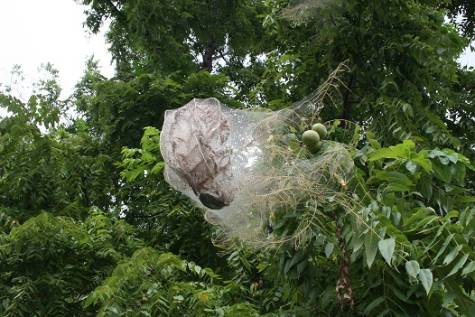Fall Webworm

While Fall webworms are present in the state throughout the entire growing season, we typically don't notice them till late summer into fall, when their nests become larger and easier to spot. These caterpillars are pale-green to yellow to nearly white with black spots and long white hairs. They are often confused with the eastern tent caterpillars in our area; however, the two can be distinguished by their webs. The fall webworm has a loosely woven web encasing entire branches, and the caterpillars feed inside the web. In contrast, the eastern tent caterpillar has a densely woven web in the crotches or forks of tree branches, and they feed outside the nest, only coming inside at night or in rainy weather. Eastern tent caterpillars are also active in the spring, while fall webworm nests are typically noticeable in the fall.
The fall webworm feeds on many trees, including birch, crabapple, maples, hickory, pecan, mulberry, and walnut. Because these caterpillars only feed inside the nest, they are difficult to control with chemicals unless you have a high-powered spray that can penetrate the web. Depending on tree size and the extent of web masses, fall webworms can be handled in several ways. Because larvae remain in the nests, removing web masses should eliminate most larvae. Fingers are efficient tools for stripping web masses from branches, but a pole with a nail driven through the end or one with a bristled toilet brush attached can be used to avoid touching the nest. Once the webbing around the nest has been torn open, local birds can help remove the pests for you, or you could spray. You can also cut the branch with the web off and dispose of it rather than use chemicals for control. Unless there are multiple nests on the tree or the tree is already stressed by other pests, most mature trees can tolerate a few fall webworm nests without any damage, especially in the fall.

Have questions? Contact our office where our Horticulture Extension Agent will assist you with questions.
Phone: (316) 321-9660
Email: callae@ksu.edu